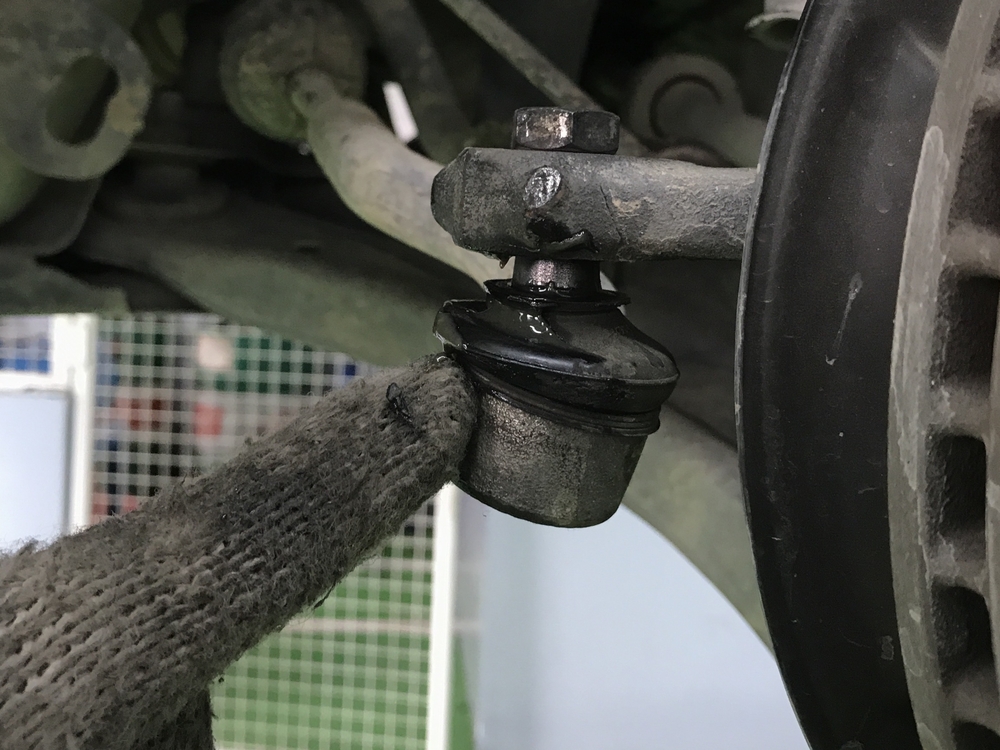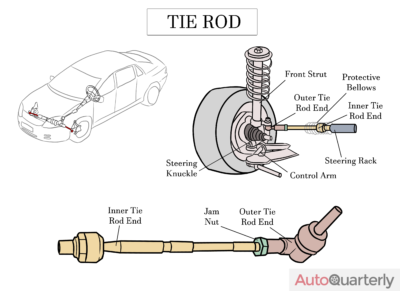While a broken tie rod end may not be the first thing you think of when your car decides to stop working, it just might be the answer to your latest car problem. In fact, your car’s tie rod ends are just as important as its power steering pump, transmission system, or engine.
Even though tie rod ends may be lesser known amongst the slew of car parts to memorize and fix, that doesn’t make them any less important to maintain.
In this article, we’ll discuss the purposes and importance of your car’s tie rod ends as they relate to the functionality of your vehicle, and then we’ll delve into a symptom checklist and guide for the costs of replacing these parts correctly.
What Is a Tie Rod End?
Tie rod ends transfer energy from the steering gear to the steering knuckle, which connects the action of the steering wheel to the tires. In addition, your car’s tie rod ends promote the accuracy of your steering by serving as the first pivot point for your vehicle’s wheels to turn along.
By ensuring that the front wheels of your car are turning at an optimal steering angle relative to the position of your steering wheel, tie rod ends serve the purpose of enhancing your ability to safely handle your car.
Inner and Outer Tie Rod Ends: What’s the Difference?
Your car’s tie rod ends serve as important stabilizers and steering control for your vehicle. This means they’re responsible for allowing you to steer accurately and precisely every time you touch the wheel. There are also two different kinds of tie rod ends, named inner and outer tie rod ends.
In a typical rack-and-pinion steering system, each side of your vehicle contains a set of inner and outer tie rod ends. They work together to connect the steering knuckle to the steering rack of your car. Here’s the difference between the two.
Inner Tie Rod End
The inner tie rod of your vehicle attaches to the steering rack of your car. As the name implies, it’s positioned in the center of the car. One end is covered by a rubber bellow, meaning that it’s less visible (and harder to access and replace) than its counterpart.
The purpose of your car’s inner tie rod end is to allow the force emanating from the steering rack to be adequately transferred to the car’s outer tie rod end. In this way, it serves as part of the bridge connecting your car’s steering rack and front wheels.
It’s the first pivot point of your car because it contains a rotating ball-and-joint socket on its end. However, it is different from an outer tie rod end because it features an in-line ball joint instead of a 90-degree angled ball joint.
Outer Tie Rod End
Unlike the inner tie rod end, your car’s outer tie rod end has a 90-degree (angled) ball joint that attaches to the steering knuckle (or the strut assembly, which then attaches to the steering knuckle). Because it is located farther from the centerline of the vehicle, it is aptly named the “outer” tie rod end.
The main purpose of the outer tie rod end is to serve as the final pivot point for your vehicle, connecting the inner tie rod end to the car’s front wheels – it’s also directly responsible for dictating the direction of your steering.
What Causes Your Car’s Tie Rod Ends to Go Bad?

Usually, the passage of time, aging, the physical depreciation of your car’s components, or other natural factors will contribute to your tie rod end’s wearing out over time.
For older cars and a few modern trucks, these vehicles require regular tie rod end fitting maintenance and oiling/greasing in order to remain working and safe to use.
Impact or other vehicular trauma can have a large impact on the status of your tie rod ends – a nasty car collision can cause a tie rod end’s lubricant-filled rubber container to break, snap, or leak all over its bearings, rendering the entire fixture useless.
Damaged tie rod ends have caused grave car crashes by producing inaccuracies in steering and promoting a lack of general vehicular control. Regularly checking up on your vehicle is important for ensuring your continued safety as a driver.
With that being said, let’s take a look at some of the major vehicular issues signaling a problem with your car’s tie rod ends.
How to Spot Issues With Your Tie Rod Ends
You’ll begin to notice some problems when your car’s tie rod ends start to wear out (or have already worn out). Handling and tire issues are common indicators of broken or worn-down tie rod ends. However, these symptoms could be caused by a host of issues.
Further issues, including loose steering, steering wheel/vehicular vibration, uneven tire wear, unusual noises, and poor wheel alignment, can all be indicative of a worn-down tie rod end.
In some cases, the symptoms listed above can be too mild to notice. This leads drivers to ignore or miss them entirely until they become a significant hazard to the safe and efficient operation of their vehicles.
Loose Steering
Loose steering is generally characterized by being able to rotate the steering wheel freely/with little resistance while failing to adequately rotate the wheels.
While loose steering can be indicative of other car issues, a loose tie rod end could be one of the culprits.
Vehicular Vibrations
A bad tie rod end can also be detected through steering wheel/vehicular vibrations.
Because tie rod ends serve as the physical connectors interlocking your steering wheel to the rest of the steering system (including your car’s front wheels), when one tie rod end fails, the impact is often immediately felt throughout the car.
A typical sign of failing tie rod ends is spotted in a shaky steering wheel that typically intensifies in vibration as you increase your car’s speed or make a turn.
Uneven Tire Wear + Poor Wheel Alignment
Even an issue as innocuous as uneven tire wear or poor wheel alignment can signal a major problem with your vehicle’s tie rod ends. This is especially the case when they occur in tandem.
Normally, well-maintained tires will wear down their tread evenly on both sides. However, if one of your car’s tires is more worn down than the others, you may be in serious trouble.
Usually, uneven tire wear indicates a more serious vehicular issue – and at the very least, it may signal a failing tie rod end throwing off your vehicle’s alignment.
A failing tie rod end may upset the balance of your vehicle’s steering alignment while inducing uneven, abnormal tire wear by pulling the car to one side of the road and utilizing the tires on one side of the car more so than the other.
Unusual Noises
Unusual noises, although a common symptom in many car issues, can also signal an issue with your vehicle’s tie rod ends. Because tie rod ends typically feature a lubricated ball stud and bearing sealed within a rubber container, they’re expected to move smoothly and quietly.
If this rubber container is damaged or broken, the lubricant may seep out of the bearing – causing the vehicle to make grinding, squeaking, or metal-on-metal scraping noises to accommodate for the sudden increase in part-to-part friction.
If your car’s problem lies with worn-down tie rod ends, you’ll notice these noises emanating from your car whenever you make a turn.
The Self-Check Method: How to See if Your Tie Rod Ends Need Repair

If you think you’re dealing with broken tie rod ends, it’s a good idea for you to visit a mechanic. However, there’s an easier way for you to determine whether it’s your car’s tie rod ends that are acting up.
Simply grasp one of your front wheels by the side while simultaneously pushing and pulling the tire to discover wiggle room/play in the wheel. You can also wiggle the tie rod itself to detect any lack of structural sturdiness within your car’s front end.
Excess mobility indicates a broken tie rod end, and repairs must be made before you can continue driving. If your car’s front wheels don’t wiggle, keep looking! Your tie rod ends are probably just fine.
Tie Rod End Replacement Cost
So, you’ve taken your vehicle to the local mechanic and confirmed that your issues stem from a pair of worn-down tie rod ends. What do you do next?
Depending on the kind of tie rod end that needs to be replaced, you’ll have two different answers.
The cost of replacing a tie rod end ranges from $100 – $400 but can vary depending on the vehicle to be fixed, the quality of the parts being used, and the skill of the mechanic responsible for completing the job.
The individual parts cost of a tie rod end may range from $20 – $100, depending on whether you’re purchasing an inner or outer tie rod end. However, here’s where the cost variation comes in.
If you’re driving an expensive car, however, these prices could rise higher. Replacing tie rod ends on a Lexus could go as high as $580, for example.
Outer tie rod ends are easier to replace. This means that you can expect to pay anywhere from $80 – $100 in labor costs (as most mechanics will charge an hour minimum).
Inner tie rod ends are harder to access and so are more expensive to replace. Most mechanics will charge significantly more – you can count on paying $150 – $300 in labor, as well as the cost of the parts. So it often comes to over $500.
You can, of course, do the job yourself. If you’re confident in your ability with cars, then this is an option.
Buy your own, high-quality aftermarket/manufacturer parts to save at least 50% of the money you’d spend on parts costs alone.
Additionally, you will need to include the cost of a front end alignment (which can range from $50-$75) in your final pricing because this procedure will be necessary after your tie rod end replacements have been made.
However, your time may be better spent searching for local retailers to work with. Oftentimes, you’ll find a local mechanic to fix your vehicle for half the price a big-name auto repair store would charge (think about visiting your local auto shop compared with visiting Pep Boys/Sears).
Tie Rod Ends – Small but Important

We hope this article and replacement guide helped you determine the best course of action to take in properly managing your vehicle when these kinds of issues arise.
Be a responsible driver by regularly checking on your vehicle to diagnose and fix any preventable, commonly occurring issues.
Replacing your tie rod ends is a task that needs to be done as soon as you suspect there is an issue with them. This is because if your steering fails, then it could result in a serious accident.
If you think your worn-down tie rod ends might be negatively impacting the vehicular performance and safety of your car, see your local mechanic today. Your car’s life (and yours) may depend on it!



